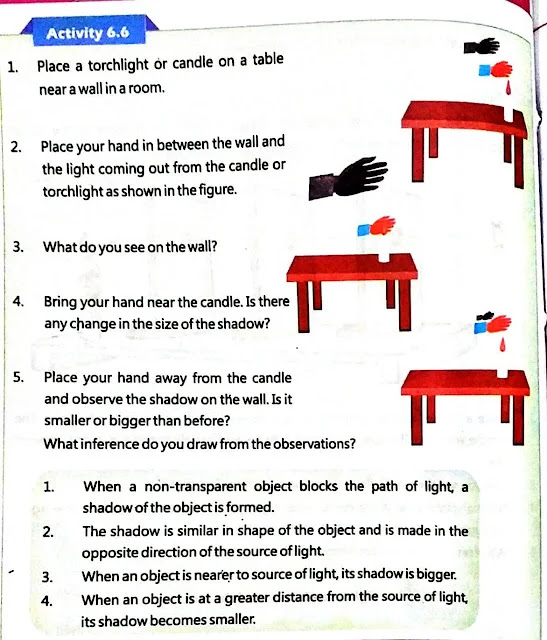General Science (G.Sc.) Class 5 Notes
Based on the Single National Curriculum, PK
(New Book/New Syllabus for 2023-2024 Exams and onward)
National Book Foundation
as
Federal Textbook Boards, Islamabad
********************************************************
as
Federal Textbook Boards, Islamabad
Activity 6.3-page #75
Transparent, Opaque, and Translucent Objects
Q1: Has the light passed through the water?
Ans: Yes, it has as we can see on the other side of the glass.
Q2: Can you see clearly across the water?
Ans: Yes, we can because it is transparent
Q3: What happens when water is replaced with milk?
Ans: The light passes but it is dim.
Q4: Has all the light passed through the glass of milk?
Ans: Light can pass partially through milk because it is translucent.
Q5: Does the booklet the light pass through it?
Ans: No, The light does not pass through a book because it is opaque.
Q6: Can you see through the book?
Ans: No, we cannot see through the opaque objects.
i. The objects through which light can pass completely are called transparent objects. We can see clearly across them.
ii. The objects through which light can pass partially are called translucent objects. We cannot see clearly through them. We can see only a faint image of the object.
iii. The objects which do not allow light to pass through them are opaque objects. We cannot see across them.
************************************
Activity 6.5 Page 77 Light travels in a Straight Line
1: Can you see the candle flame from the hole of the last card?
Ans: Candle flame can be seen when all the holes and flame are in a straight line.
2: Can you see the candle flame through the hole if the cardboard is displaced?
Ans: No, the candle flame is not visible when the cardboard is displaced.
3: How would you conclude your observations?
Ans: When all the holes are in a straight line with the flame, it is visible but we cannot see it even if a single cardboard is displaced. It proves that light travels in a straight line.
************************************
Activity 6.6 Page 78
Formation of Shadows
Q1: What do you see on the wall?
Ans: The shadow similar in shape to the object is formed on the wall.
Q2: What happens to the shadow if you bring your hand near the candle?
Ans: When the hand is nearer to the candle, its shadow is bigger.
Q3: Is there any change in the size of the shadow if you move your hand away from the candle?
Ans: When the hand is moved away from the candle, its shadow becomes smaller.
Q4: How do you think a shadow is formed?
Ans: When a non-transparent object blocks the path of light, a shadow of the object is formed.
Q5: What do you conclude from the observation?
Ans: Shadows are formed when a non-transparent object comes in the path of light and the size of the shadows: depends upon the distance of an object from the source of light.
************************************
Shortcut Links For:
2. 5th Class: Social Study (S.St.) Notes
3. 5th Class: General Science (G.Sc.) Notes
4. 5th Class: Urdu (اُردو) Notes
5. 5th Class: Islamiyat (اسلامیات) Notes
6. 5th Class: Mathematics Notes
1. Website for School and College Level Physics 2. Website for School and College Level Mathematics 3. Website for Single National Curriculum Pakistan - All Subjects Notes
© 2022 & onwards Academic Skills and Knowledge (ASK)
Note: Write me in the comments box below for any query and also Share this information with your class-fellows and friends.
2. 5th Class: Social Study (S.St.) Notes
3. 5th Class: General Science (G.Sc.) Notes
4. 5th Class: Urdu (اُردو) Notes
5. 5th Class: Islamiyat (اسلامیات) Notes
6. 5th Class: Mathematics Notes





0 Comments
Note: Write me in the comments box below for any queries and also Share this information with your class-fellows and friends.